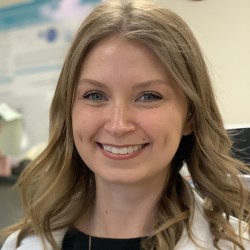
Amanda Collar, PhD
— MEDICAL SCHOOL —
University of New Mexico School of Medicine
— GRADUATING CLASS —
2024
As a new third-year medical student, Gynecologic Oncology (Gyn–Onc) clinic was particularly anxiety-inducing. Even within the already jargon-filled profession of medicine, Gyn–Onc has its own language filled with staging, therapeutics, and surgical interventions that I knew very little about.
I pick up the first patient's file and breathe a sigh of relief. A woman in her 50s with a past medical history of human papillomavirus (HPV) and cervical cancer post-hysterectomy is here to discuss the results of her recent vaginal cuff Pap smear. In the grand scheme of Gyn–Onc clinic, this seemed like a relatively simple visit. After all, I had learned about HPV and cervical cancer.
I felt confident walking into the patient's room to discuss with her that she continues to have detectable HPV infection, as we would expect, and that we will continue to monitor. However, after establishing that she is not experiencing any new symptoms and that she is doing well, I hardly get a sentence out about her test results before I am stopped.
"Wait…what is HPV?"
I'm confused by the question since she has already undergone surgery to treat this cancer-causing infection. I begin to explain that HPV is a common virus that can cause cancers, like cervical cancer. I am again stopped to address her question about how she may have gotten this infection. As I begin to explain that HPV is typically transmitted during sexual activity, she stops me again.
"I have an STD?"
Before I can even address this question, she is in tears. Her perceived stigma of having a sexually transmitted infection is palpable as she makes statements like she is "not that type of girl" and that she "should never have married her ex-husband."
I comfort her. I tell her that I wish she didn't feel this way and that I am making no judgements. I normalize the situation, emphasizing how common this infection really is. I praise her for asking questions and continuing to seek care. But mostly, I apologize that there was a breakdown in communication in her previous appointments.
Medical students learn approximately 55,000 new words in the 4 years of medical school. We learn to convert bloody nose to epistaxis, dilated pupil to mydriasis, and unknown cause to idiopathic seamlessly. This new language is drilled in. Indeed, I've been stopped mid-patient presentation to restate the findings using this new language instead ("What's a better word you could use to describe that?").
But learning the talent of code-switching—which in this context means converting medical jargon back into lay language—is the real talent. More than that, it's a job necessity with more than half of Americans having literacy below a sixth-grade level. Indeed, effective physician communication is associated with positive patient outcomes, like patient recall, understanding, and adherence. It can also help to reduce the risk of medical errors.
I'm embarrassed to say that during my first 2 years of medical school, I often found the courses focused on effective communication (like learning how to "NURSE"—name, understand, respect, support, and explore patient's emotions) overwhelming in the face of learning "real medicine" in my other didactic courses. How could I focus on becoming an effective communicator when I was still learning the basics of human disease? Why was it important to learn how to approach medicine with empathy when I had to learn the cardiac cycle that same week?
Looking back, I'm so happy that my medical school emphasized these skills early on and reinforced the practice throughout our clinical years. Sitting bedside, being trusted with a patient's story is the most rewarding aspect of our career as physicians, and I'm excited to continue learning best practices in patient communication through evidence-based practice and from role models.
Back to the April 2024 issue of ACP IMpact

